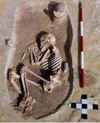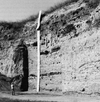European Prehistory Flashcards

C.J Thomsen. Three Age System.
- Neolithic
- Copper Age (Chalcolithic)
- Bronze Age
- Iron Age.
Danish Museum. 19th century

Sesklo model house.
- village near the city of Volos Thessaly, Greece. • Neolithic settlement
- in its peak period around 5000 BC and comprised about 500 - 800 houses with a population of perhaps up to 5,000 people
- Sesklo culture

Lepenski Vir, Serbia
Mesolithic-Neolithic transition c. 9500 to 5500 BC
- Rectangular stone-lined hearth very early – open air?
- c. 7000 BC trapezoidal structures - mimicking mountain
- c. 6200 BC more elaborate structures at other sites - Red limestone floors, central hearths

- Linearbandkeramik society - from the Black Sea to the Atlantic. Central Europe.
- Neolithic c. 5500 – 4500 BC

Linearbandkeramik burials
Earlier thinking, based on smaller dataset – exceptionally unified burial ritual In reality, current data: LBK funerary practices are very variable:
- Whole and partial burials
- Cremations and possible secondary interments/manipulations
- Cemetery, settlement and cave contexts

Talheim, Germany (LBK, 5000BC)
2 m deep pit
Women, men, children – at least 34 individuals Complete population from small village?
20/34 skulls with unhealed trauma All ages, both sexes

Rondels (c. 4700 BC)
- Circular/elliptical
- Approx 120–150 enclosures known in Central Europe
- Lasting for about 200–300 years
- Opposing entrances; cardinal/astronomical alignments
- Cultic? Sun worship?

Peak of Clay Figurines in the middle Neolithic, particularly in Tell Economies in SE Europe, 4000BC ish

Varna Cemetery: Bulgaria,
- The oldest golden treasure in the world
- Dating from 5 th millennium BC
Gold and Copper in abundance
Personal adornment; graves and ‘cenotaphs’
Grave 14 Short-lived 4560-4450 BC

Tripolye Mega-Villages
5 th millennium BC
Several hundred houses
Never grew into tells

Movement and concentration of jade tools in europe

Continuing complexity and social differentiation
Iberian Copper Age c. 2800-2200 BC
e.g. Los Millares; Valencina de la Concepción
Potentially Scythian? Personal Adornment

Corded Ware complex c. 2800-2100 BC
The beaker – drinking vessel; cord-impressed decoration Battle axes Individual graves

Bell Beaker Phenomenon, c. 2800 – 1800 BCE
Bronze-working
Archery equipment
Copper daggers
Long-distance Movement
Metal ore sources?

The Amesbury Archer (UK) Bell Beaker Phenomenon c. 2400 BC
Most well-furnished grave in Britain
Mobility – oxygen Isotopes
Mainland Europe childhood

Nebra Sky Disk c. 1600 BC
Eastern Germany
Bronze and gold disc
Concern with astronomical bodies

The Warrior’s beauty - eleborate design on swords, shields, armour.

- Scythians
- Eurasian nomads
- 7th century BC until about the 1st century BC
- Famous for gold, warfare and tattoos

‘Princely centres’ Hilltop enclosures overlooking large burial mounds with richly-furnished graves Demise 5th century BC - abandoned
Mont Lassois

‘Princely centres’ Hilltop enclosures overlooking large burial mounds with richly-furnished graves Demise 5th century BC - abandoned
Heuneburg

The “Lord of Glauberg” statue (c. 500 BC)
The Glauberg is a Celtic oppidum in Hesse, Germany consisting of a fortified settlement and several burial mounds, “a princely seat of the late Hallstatt and early La Tène periods. (An oppidum is a large fortified Iron Age settlement)

The La Tène culture was a European Iron Age culture named after the archaeological site of La Tène on the north side of Lake Neuchâtel in Switzerland. circa 500 BCE. — circa 1 BCE. Distinctive celtic art and design.

Sesklo, Greece c. 6500 BC onwards Fertile alluvial plains of Thessaly, east-central Greece
A key centre of Early Neolithic farming communities Densely settled Thessaly
Flat settlements or settlement mounds (tells) Or a mixture of both

Karanovo, Bulgaria: 12m high – occupation over thousands of years

Aiterhofen cemetery, Lower Bavaria, Germany 159 inhumations and 69 cremations – one of the largest LBK cemeteries excavated so far c. mid LBK (5300/5250 BC) to middle Neolithic (5000/4900 BC)

Copper axes – Red Jadeitite axes – Green Flint axes – Black
Spread of different materials for tool making in Europe

Bronze Age Emerging Elites - princes - warriors Accumulation of Wealth - Treasures Production Trade Centralisation

Iron Age Hallstatt-period c. 800-450 BC

Spread of Iron in the near east and Europe around 1200BC - 1BC

The Hochdorf Chieftain’s Grave is a richly-furnished Celtic burial chamber dating from 530 BC, Hallstatt D period. An amateur archaeologist discovered it in 1977 near Hochdorf. Germany. It includes gold and amber jewellery, weapons and rich clothing.


